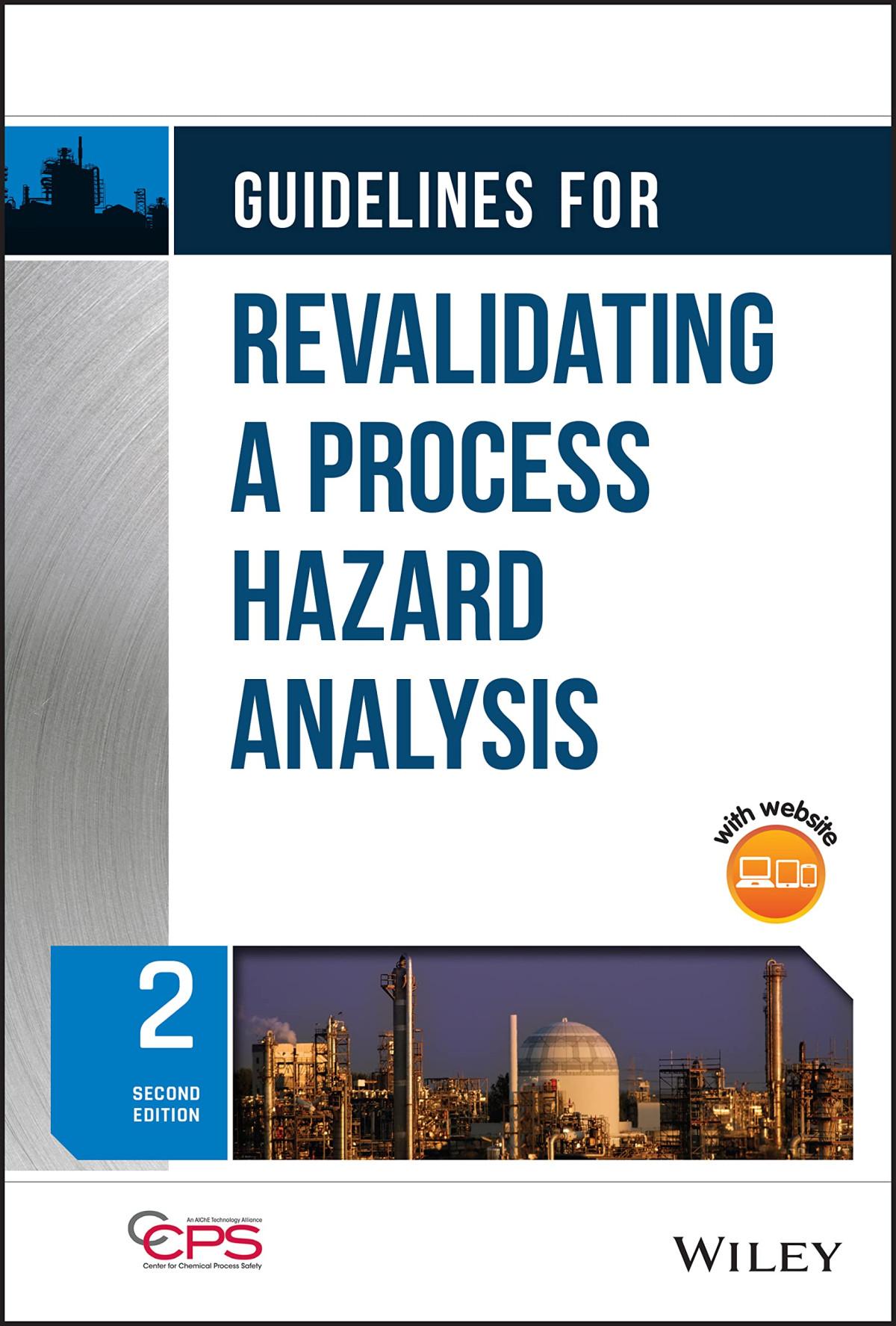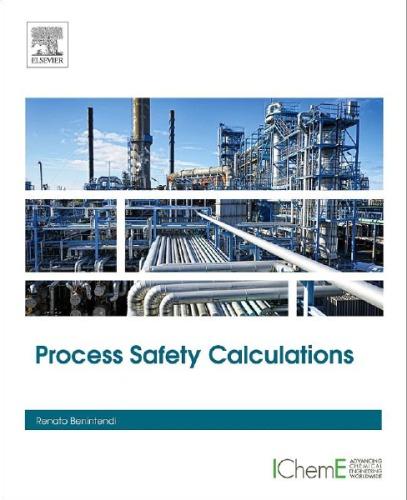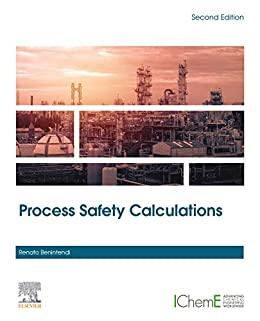More Incidents that Define Process Safety
It is our sincere intention that the information presented in this document will lead to an even more impressive safety record for the entire industry; however, neither the American Institute of Chemical Engineers (AIChE), its consultants, CCPS Technical Steering Committee and Subcommittee members, their employers, their employers’ officers and directors, warrant or represent, expressly or by implication, the correctness or accuracy of the content of the information presented in this document. As between (1) AIChE, its consultants, CCPS Technical Steering Committee and Subcommittee members, their employers, their employers’ officers and directors, and (2) the user of this document, the user accepts any legal liability or responsibility whatsoever for the consequence of its use or misuse. and stayed internal to organization
2.4
5.2
5.3
5.4
5.5
5.6
5.7
5.8
5.9
5.10
5.11
6 More Incidents that Define Process Safety
List of Figures
Figure 1.2-1. Risk Based Process Safety (RBPS) approach
Figure 2.2-1. A portion of the 3-inch thick reactor (courtesy CSB).
Figure 2.2-2. T2 Laboratories blast (courtesy CSB).
Figure 2.2-3. T2 Reactor.
Figure 2.3-1. Reaction Sequence for Hoechst Griesheim Runaway Reaction. This reaction is exothermic, with a heat of reaction of 140 kJ/mole (132.7 BTU/mole) 2-chloronitrobenzene.
Figure 2.4-1. Process flow diagram of the wastewater tank (courtesy CEP).
Figure 2.6-1. Fertilizer building overview (courtesy CSB).
Figure 2.6-2. Southwest view of Fertilizer Building (adapted from CSB).
Figure 2.6-3. WFC and community growth (courtesy CSB).
Figure 2.6-4. Overview of damaged EFC (courtesy CSB).
Figure 2.6-5. Apartment complex damage (courtesy CSB video).
Figure 2.6-6. Soot accumulation on FGAN pile (courtesy CSB video).
Figure 2.7-1. The crater from 2015 Tianjin explosion (courtesy Shutterstock).
Figure 2.8-1. Neutralizer and rundown tank, source (courtesy EPA).
Figure 2.8-2. AN plant area after the explosion (courtesy EPA).
Figure 2.9-1. Control room and office building after a jet flame impact (courtesy HSE).
Figure 2.9-2. 360 base still (courtesy HSE).
Figure 2.9-3. Still base and control room (courtesy HSE).
Figure 3.2-1. Fine powdered metal collected from the Hoeganaes plant (penny shown for scale) (courtesy CSB).
Figure 3.2-2. Computer graphic of maintenance workers inspecting bucket elevator (courtesy CSB).
Figure 3.2-3. The scene of January 2011 incident (courtesy CSB).
Figure 3.2-4. Iron dust on rafters and overhead surfaces, February 3, 2011 (courtesy CSB).
Figure 3.2-5. Hole in 4-inch piping after the May 27, 2011 incident (courtesy CSB).
Figure 3.3-1. Vapor cloud and ignition seen from Marin County (courtesy CSB).
Figure 3.3-2. Atmospheric separation process flow diagram (courtesy OSHA).
Figure 3.3-3. Timeline (courtesy CSB).
Figure 3.3-4. Location of the leak (courtesy CSB).
Figure 3.3-5. Ruptured Crude Unit #4-sidecut pipe at Chevron refinery (courtesy CSB).
Figure 3.3-6. Chevron’s new Leak Response Protocol (courtesy CSB).
Figure 3.4-1. Process Flow Diagram of PDA unit (courtesy CSB).
Figure 3.4-2. Abandoned propane mix control station (courtesy CSB).
Figure 3.4-3. Crack in the propane mix control station piping (courtesy CSB).
Figure 3.4-4. Photograph of damaged PDA unit, showing the location of butane sphere and chlorine cylinders (courtesy CSB).
Figure 3.5-1. Typical vacuum truck used to haul oilfield waste liquids (courtesy CSB).
Figure 3.5-2. Disposal/washout pad, hydraulic pumps and wooden stop beam (courtesy CSB).
Figure 3.5-3. Layout of disposal/washout pad, vacuum trucks, and injuries (courtesy CSB).
8 More Incidents that Define Process Safety
Figure 3.5-4. Damaged trucks and disposal/washout pit area (courtesy CSB).
Figure 4.1-1. Relationships between the different types of explosions. It is possible for several to occur with any incident (courtesy Crowl 2003).
Figure 4.2-1. Buncefield storage depot after the explosion and fires (courtesy Buncefield).
Figure 4.2-2. Buncefield storage depot before the explosion (courtesy Buncefield).
Figure 4.2-3. Buncefield site – the extent of vapor cloud (gray line) (courtesy HSE).
Figure 4.2-4. Breakup of liquid into drops spilling from tank top (adapted from HSE).
Figure 4.2-5. Fires at CAPECO site (courtesy CSB).
Figure 4.3-1. Jaipur site before explosion (courtesy HSE).
Figure 4.3-2. Jaipur site after explosion (courtesy HSE).
Figure 4.3-3. Burning storage tanks at Jaipur (courtesy SK Roy, HSE for IOC).
Figure 4.3-4. Pipeline schematic (courtesy SK Roy, HSE for IOC).
Figure 4.3-5. Hamer blind valve after explosion (courtesy SK Roy, HSE for IOC).
Figure 4.4-1. Oxidation reactor after the explosion (courtesy Celanese).
Figure 4.4-2. One of several units impacted by explosion (courtesy Celanese).
Figure 4.4-3. Schematic of oxidation reactor (courtesy Celanese).
Figure 4.4-4. Predicted flammable vapor cloud from reactor explosion (courtesy Celanese).
Figure 4.5-1. Fireball in Williams Geismar plant (courtesy CSB).
Figure 4.5-2. Schematic of propylene fractionator (adapted from CSB).
Figure 4.5-3. Reboiler B after the explosion (courtesy CSB).
Figure 4.5-4. Example of car seal on a valve handle (www.totallockout.com/online-store/car-seals-2/ (accessed November 19, 2015)) (courtesy CSB).
Figure 4.5-5. Ruptured heat exchanger at Goodyear Texas plant (courtesy CSB).
Figure 4.6-1. Imperial Sugar refinery after the explosion (courtesy CSB).
Figure 4.6-2. Imperia Sugar facility before the explosion. Granulated sugar storage silos and packing buildings are circled. Raw sugar warehouses in lower right (Chatham County, GA GIS photo) (CSB 2009a)
Figure 4.6-3. Imperial Sugar Refinery after the explosion (courtesy CSB).
Figure 4.6-4. Motor cooling fins and fan guard covered with sugar dust; large piles of sugar cover the floor (courtesy CSB).
Figure 4.6-5. Secondary dust explosion (courtesy U.S. OSHA).
Figure 4.7-1. Reverberatory furnace at Hayes Lemmerz plant (courtesy CSB).
Figure 4.7-2. Dust collection system at Hayes Lemmerz plant (courtesy CSB.
Figure 4.7-3. Dust collector and drop box remains after the explosion (courtesy CSB).
Figure 4.8-1. Pipeline fires at Varanus Island (courtesy Bills and Agostini).
Figure 4.8-2. Ruptured 12” sales gas line (courtesy Bills and Agostini).
Figure 4.9-1. Gas-fired water heater piping and likely release points (courtesy CSB).
10 More Incidents that Define Process Safety
Figure 4.9-2. ConAgra Plant explosion aftermath (courtesy CSB).
Figure 4.9-3. Location of natural gas outlet (oval) at Kleen Energy (courtesy CSB).
Figure 4.10-1 Outdoor storage tanks after explosions (courtesy Marmo).
Figure 4.10-2 Indoor storage facility after explosions (courtesy Marmo).
Figure 4.10-3. Schematic of tank farm (adapted from Marmo).
Figure 4.11-1. Ruptured vessel and damaged building at NDK (courtesy CSB).
Figure 4.11-2. Cross section of crystallization vessel (not to scale) (courtesy CSB).
Figure 5.2-1. Fire on Deepwater Horizon, source (courtesy CSB).
Figure 5.2-2. Location of mud-gas separator and diverter lines (courtesy CSB).
Figure 5.2-3. Macondo Well blowout preventer, source (courtesy CSB).
Figure 5.3-1 – Flow path from Freedom Industries to West Virginia American Water Kanawha Valley Treatment Plant (courtesy CSB).
Figure 5.3-2 – Layout of Freedom Industries site (courtesy CSB).
Figure 5.4-1 – Location of Millard Refrigerated on Theodore, Alabama Industrial Canal (courtesy CSB).
Figure 5.5-1 – DuPont building housing the Lannate® unit (courtesy CSB).
Figure 5.5-2 – Location where drain valves were opened.
Figure 5.6-1 – Photo of hose used to transfer phosgene (courtesy CSB)
Figure 5.7-1 – Failed chlorine transfer hose and release (courtesy CSB).
Figure 5.8-1 – Layout of tank truck unloading station (courtesy CSB).
Figure 5.10-1 – Hube Global and surrounding area (courtesy Korea Institute of Public Administration).
Figure 5.10-2 – Hube Global HF release (courtesy of Korea Institute of Public Administration).
Figure 5.10-3 – Crop damage due to Hube Global HF release (courtesy of Korea Institute of Public Administration). The sign in this photograph reads "Hydrofluoric Acid release accident disaster area. Absolutely no consumption or use. ~ Gumi City Safety Counsel."
Figure 6.2-1. Lac-Megantic tank cars with breaches to their shells.
Figure 6.2-2. DOT-117 Train car (courtesy DOT).
Figure 6.3-1. Norfolk Southern Railway freight train derailment site (courtesy NTSB).
Figure 6.5-1. PG&E pipeline rupture and fire in San Bruno (courtesy NTSB).
Figure 6.5-2. Weld in failed PG&E pipeline (courtesy NTSB).
Figure 6.5-3. Properly made weld (courtesy NTSB).
Figure 6.6-1. Burned vegetation along the creek from Olympic pipeline release and fire (courtesy NTSB).
Figure 7.2-1. Fukushima Daiichi nuclear reactor design (courtesy IAEA).
12 More Incidents that Define Process Safety
Figure 7.2-2. Fukushima Daiichi incident progression (courtesy IAEA).
Figure 7.2-3. Fukushima Daiichi nuclear power plant elevations (courtesy Tokyo Electric Power Company) (OP: Sea level at Onahama Port).
Figure 7.3-1. Sewol Ferry capsizing and sinking (courtesy South Korea Coast Guard & South Korea Media, Straits Times graphic adapted from AFP).
Figure 7.4-1. Pike River Mine (courtesy stuff.co.nz).
Figure 7.5-1. Shearer cutting coal (courtesy GIIP).
Figure 7.6-1. Flammability range of hydrogen, oxygen and carbon dioxide as was handled in the University of Hawaii incident (courtesy UC).
Figure 7.6-2. Swiss cheese model representing potential failures in university chemical laboratory process safety management (courtesy CSB).
ACRONYMS AND ABBREVIATIONS
ABET Accreditation Board for Engineering and Technology, Inc. (US)
AFPM American Fuel and Petrochemical Manufacturers
AIChE American Institute of Chemical Engineers
AIHA American Industrial Hygiene Association
ALARP As Low As Reasonably Practicable
AMF Automatic Mode Function
AN Ammonium Nitrate
API American Petroleum Institute
APTAC Automatic Pressure Tracking Adiabatic Calorimeter®
ARC Accelerating Rate Calorimeter™
ASME American Society of Mechanical Engineers
ATC Air Traffic Control
ATG Automatic Tank Gauging
BEA Bureau of Investigation and Analysis (France)
BLEVE Boiling Liquid Expanding Vapor Explosion
BOEMRE Bureau of Ocean Energy Management Regulation and Enforcement
BOP Blowout Preventer
14 More Incidents that Define Process Safety
BS&W Basic Sediment and Water
BSEE Bureau of Environmental Enforcement (US)
BSR Blind Shear Ram
CalEPA California Environmental Protection Agency
CCPS Center for Chemical Process Safety
CFR Code of Federal Registry (US)
COMAH Control of Major Accident Hazards (UK)
COO Conduct of Operations
CP Cathodic Protection
CRW Chemical Reactivity Worksheet
CSB Chemical Safety and Hazard Investigation Board (US)
DDT Deflagration to Detonation Transition
DDT Dichlorodiphenyltrichloroethane
DHS Department of Homeland Security (US)
DMP Department of Mines and Petroleum (Australia)
DNT Dinitrotoluene
DOCEP Department of Consumer and Employment Protection (Australia)
DOIR Department of Industry and Resources (Australia)
DOJ Department of Justice (US)
DOT Department of Transportation (US)
EIV Emergency Isolation Valve
EPCRA Emergency Planning and Community Right-toKnow Act (US)
EPA Environmental Protection Agency (US)
ERPG Emergency Response Planning Guideline (US)
ERS Emergency Relief System
ERT Etowah River Terminal, LLC
ESD Emergency Shutdown System
ETC Energy Technology Center Chevron
EU European Union
FGAN Fertilizer Grade Ammonium Nitrate
FMG FM Global
FRC Flame retardant clothing
GE General Electric Company
H2S Hydrogen Sulfide
HAZMAT Hazardous Materials
HAZOP Hazard and Operability Study
HCl
Hydrogen Chloride
16 More Incidents that Define Process Safety
HDPE High-density polyethylene
HF Hydrofluoric Acid
HIRA Hazard Identification and Risk Analysis
HOV Hand Operated Valve
HSE Health & Safety Executive (UK)
IAEA International Atomic Energy Agency
ICC International Code Council
IDLH Immediately Dangerous to Life and Health
IDPS Incidents that Define Process Safety
IFC International Fire Code
IFGC International Fuel Gas Code
IHLS Independent High-Level Switch
LEL Lower Explosive Limit
LOPC Loss of Primary Containment
LPG Liquefied Petroleum Gas
LPO Liquid phase oxidation
LRP Leak Response Protocol (Chevron)
MAWP Maximum Allowable Working Pressure
MEC Minimum Explosion Concentration
MCHM Methylcychohexanemethanol
MCMT Methylcyclopentadienyl manganese tricarbonyl
MCO Mars Climate Orbiter
MCPD methylcyclopentadiene
MI Mechanical Integrity
MIC Methyl isocyanate
MIIB Major Incident Investigation Board (UK)
MMA Montreal, Main & Atlantic Railway
MMS Mineral Management Service (US)
MNT Mononitrotoluene
MOC Management of Change
MOM Ministry of Manpower (Singapore)
MoP&NG Ministry of Petroleum and Natural Gas (India)
MOV Motor Operated Valve
MSD Material Safety Data
MSHA Mining Health and Safety Administration (US)
NAIIC Nuclear Accident Independent Investigation Commission
NASA National Aeronautics and Space Administration
NaSH Sodium hydrosulfide
NDK Nihon Dempa Kogyo Company
18 More Incidents that Define Process Safety
NEC National Electrical Code
NEP National Emphasis Program (US)
NFPA National Fire Protection Association
NOPSA National Offshore Petroleum Safety Authority (Australia)
NPDES National Pollutant Discharge Elimination System (US)
NTSB National Transportation and Safety Board
OGJ Oil and Gas Journal
ONRR Office of Natural Resources Revenues
OMS Operating Management System (BP)
OSHA Occupational Safety and Health Administration (US)
P&ID Piping and Instrumentation Diagram
PA Public Address
PDA Propane Deasphalting
PFD Process Flow Diagram
PGERA Petroleum and Geothermal Energy Resources Act (Western Australia)
PG&E Pacific Gas and Electric Company
PHA Process Hazard Analysis
PHMSA Pipeline and Hazard Materials Safety Administration (US)
PMI Positive Material Identification
PPA Petroleum and Pipeline Act (Western Australia)
PPE Personal Protective Equipment
PRV Pressure Relief Valve
PSLA Petroleum Submerged Lands Act (Western Australia)
PSM Process Safety Management
PSSR Pre-Start-up Safety Review
PSV Pressure safety valve
PTFE Polytetrafluoroethylene
QA Quality Assurance
RBPS Risk Based Process Safety (CCPS)
RHIL Rui Hai International Logistics
RMP Risk Management Plan
RSOV Remote Shutoff Valves
SABIC Saudi Basic Industries Corporation
SADT Self-Accelerating Decomposition Temperature
SERC State Emergency Response Committee
SCADA Supervisory Control and Data Acquisition
20 More Incidents that Define Process Safety
SCBA Self-contained Breathing Apparatus
SCC Stress Corrosion Cracking
SDS Safety Data Sheet
SGL Sales gas pipeline
SOP Safe Operating Procedure
SWA Stop Work Authority
SWP Safe Work Practices
TEPCO Tokyo Electric Power Company
TGAN Technical Grade Ammonium Nitrate
TNT Trinitrotoluene
TWA PEL Time Weighted Average Permissible Exposure Limit
UEL Upper Explosive Limit
UK United Kingdom
US United States
VBR Variable Bore Rams
VCE Vapor Cloud Explosion
VSP Vent Sizing Package™
WFC West Fertilizer Company
WVAW West Virginia American Water
WVDEP West Virginia Department of Environmental Protection
GLOSSARY
Many of these terms and definitions are taken from the CCPS Glossary, which is continually updated. Please check the glossary at www.aiche.org/ccps/resources/glossary for the most current definition.
Asset Integrity
Atmospheric Storage Tank
Boiling Liquid Expanding Vapor Explosion (BLEVE)
Combustible Dust
The condition of an asset that is properly designed and installed in accordance with specifications and remains fit for purpose.
A storage tank designed to operate at any pressure between ambient pressure and 0.5 psig (3.45 kPa gauge).
A type of rapid phase transition in which a liquid contained above its atmospheric boiling point is rapidly depressurized, causing a nearly instantaneous transition from liquid to vapor with a corresponding energy release. A BLEVE of flammable material is often accompanied by a large aerosol fireball, since an external fire impinging on the vapor space of a pressure vessel is a common cause. However, it is not necessary for the liquid to be flammable to have a BLEVE occur.
A finely divided combustible particulate solid that presents a flash-fire hazard or explosion hazard when suspended in air or the process specific oxidizing medium over a range of concentrations. 22 More Incidents
Combustible Liquid
Conduct of Operations (COO)
A term used to classify certain liquids that will burn on the basis of flash points. The National Fire Protection Association (NFPA) defines a combustible liquid as any liquid that has a closed-cup flash point above 100°F (37.8°C) (NFPA 30). There are three subclasses, as follows; Class II liquids have flash points at or above 100°F (37.8°C) but below 140°F (60°C). Class III liquids are subdivided into two additional subclasses; Class IIIA: Those having flash points at or above 140° F (60°C) but below 200°F (93.4°C), Class IIIB: Those having flash points at or above 200°F (93.4°C). The Department of Transportation (DOT) defines combustible liquids as those having flash points above 140°F (60.5°C) and below 200°F (93.4°C).
The embodiment of an organization’s values and principles in management systems that are developed, implemented, and maintained to (1) structure operational tasks in a manner consistent with the organization's risk tolerance, (2) ensure that every task is performed deliberately and correctly, and (3) minimize variations in performance.
Confined Space
A confined space has limited or restricted means for entry or exit and is not designed for continuous occupancy. Confined spaces include, but are not limited to, tanks, vessels, silos, storage bins, hoppers, vaults, pits, manholes,
Deflagration
Detonation
Emergency Isolation Valve (EIV)
Emergency Planning and Community Rightto-Know Act (EPCRA)
tunnels, equipment housings, ductwork, pipelines, etc. (OSHA 2019)
Combustion that propagates by heat and mass transfer through the unreacted medium at a velocity less than the speed of sound.
A release of energy caused by the propagation of a chemical reaction in which the reaction front advances into the unreacted substance at greater than sonic velocity in the unreacted material.
An EIV is a special category of valve that is dedicated to the purpose of isolating large inventories of flammable or toxic material from sources or equipment whose relative likelihood of significant leakage is high. (AIChE.confex.com)
The Emergency Planning and Community Right-to-Know Act (EPCRA) of 1986 was created to help communities plan for chemical emergencies. It also requires industry to report on the storage, use and releases of hazardous substances to federal, state, and local governments. EPCRA requires state and local governments, and Indian tribes to use this information to prepare their community from potential risks.
Explosion
The bursting or rupture of an enclosure or container due to the development of internal pressure from a deflagration.















